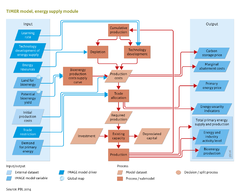Energy supply/Policy issues: Difference between revisions
Jump to navigation
Jump to search
No edit summary |
Oostenrijr (talk | contribs) No edit summary |
||
| Line 11: | Line 11: | ||
* Sustainability criteria for bioenergy production may restrict production in water-scarce areas. | * Sustainability criteria for bioenergy production may restrict production in water-scarce areas. | ||
* Production targets are mostly set to force technologies through a learning curve. | * Production targets are mostly set to force technologies through a learning curve. | ||
The influence of stringent climate policy on production of primary energy resources is shown in | The influence of stringent climate policy on production of primary energy resources is shown in the figure below. Climate policy leads to a major shift from a system mostly based on fossil fuels to an increase in the use of nuclear power, renewable energy, bioenergy and {{abbrTemplate|CCS}} technology, with a correspondingly lower reliance on fossil fuels. The choice of these alternative options depends on assumptions made in the model, as shown in the scenarios in the study [[Roads from Rio+20 (2012) project|Roads from Rio+20]] ([[PBL, 2012]]). Three pathways based on different initial assumptions emphasise different combinations of primary energy carriers, each time within a stringent emission constraint. | ||
}} | }} | ||
Revision as of 09:09, 24 June 2014
Parts of Energy supply/Policy issues
| Component is implemented in: |
|
| Related IMAGE components |
| Projects/Applications |
| Key publications |
| References |
